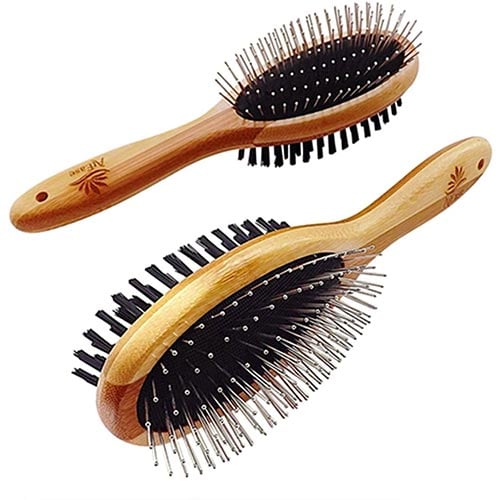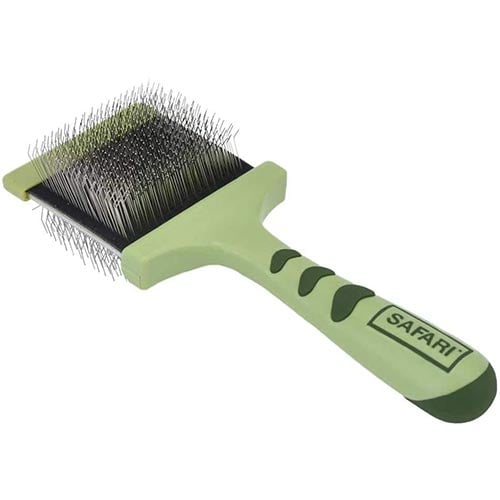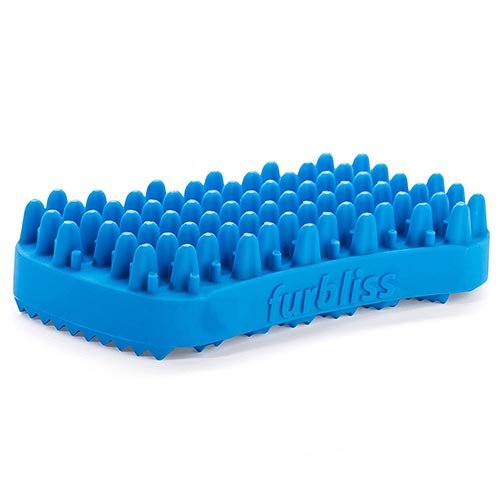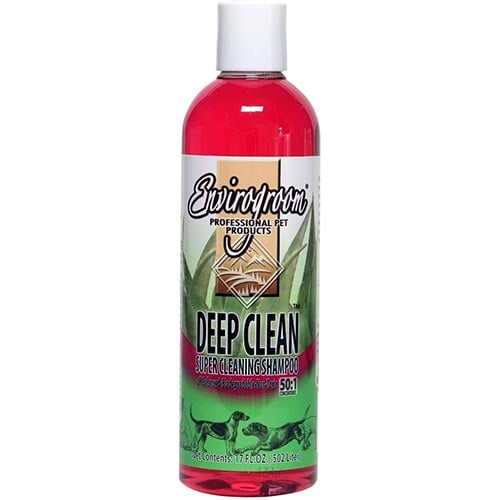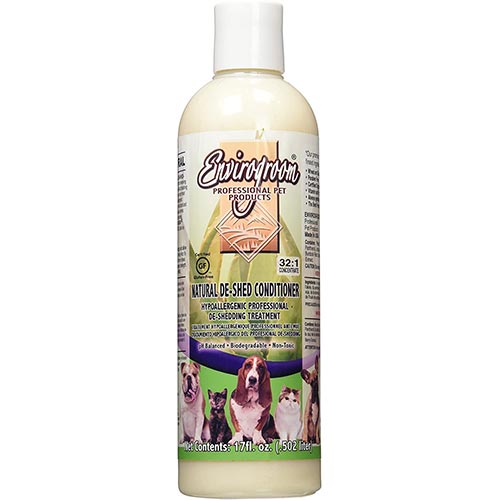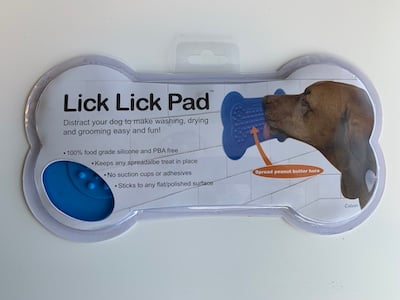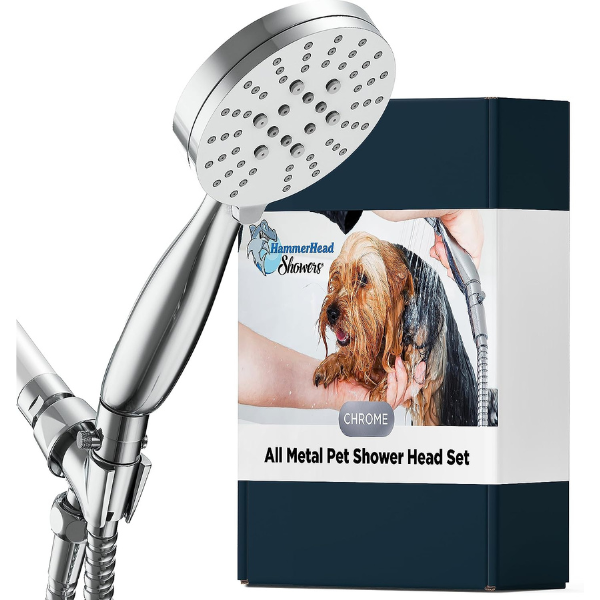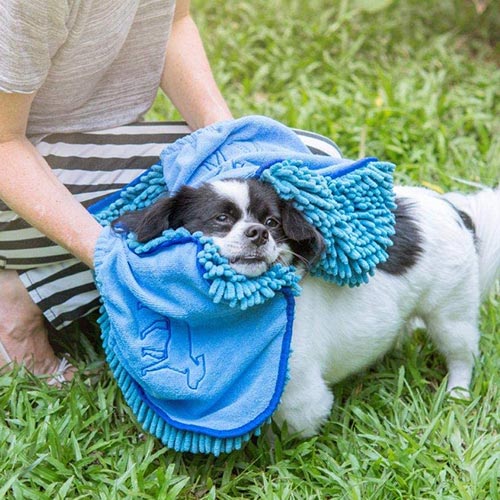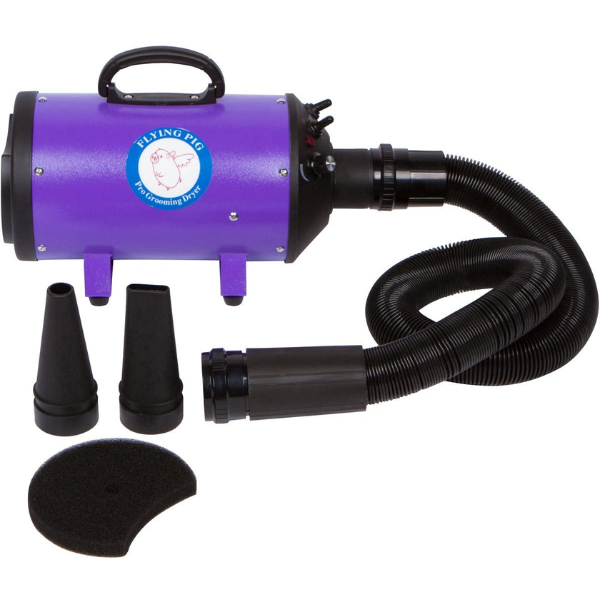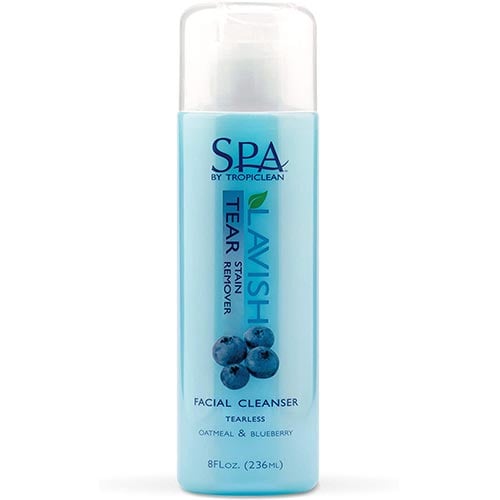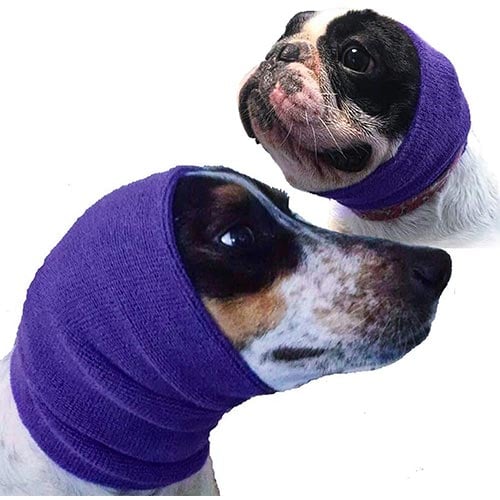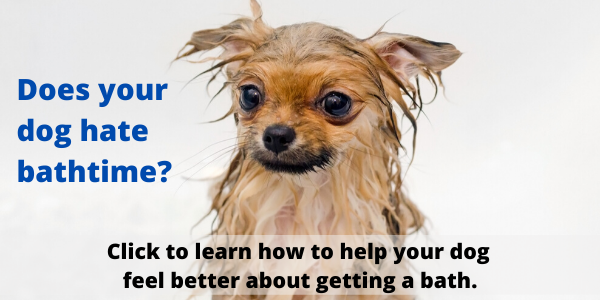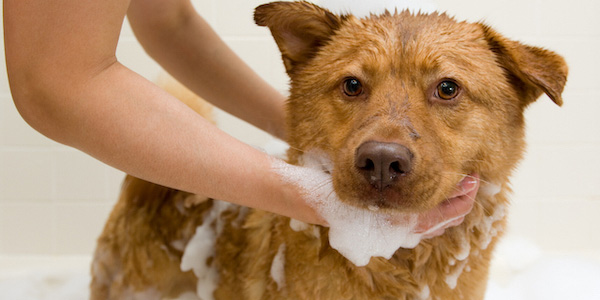 Is the Eau de Dogue getting a bit too much to handle? The idea of washing your dog at home might seem like quite an undertaking, especially if your dog takes off running at the quietest mention of a "bath."
Is the Eau de Dogue getting a bit too much to handle? The idea of washing your dog at home might seem like quite an undertaking, especially if your dog takes off running at the quietest mention of a "bath."
But giving your dog a good scrub doesn't have to be hard, and learning how to do it at home can mean less frequent professional grooming appointments.
For some dogs, baths are as simple as wash, rinse, and dry. But there are a couple of things to be mindful of to prevent problems like matting and knots, impacted fur, hot spots, or ear infections.
Proper bathing is important to keep your dog's skin and coat healthy.
You might be wondering how often you should bathe your dog, what shampoos are best for sensitive skin, or how to wash a dog that hates baths. Read on for tips and tricks to make bath time a breeze!
Dog Bathing Supplies
Dog Washing Steps
Drying Your Dog After Their Bath
Help Your Dog Feel Better About Baths
When to See a Professional Groomer
How Often Should You Wash Your Dog?
How often you should bathe your dog depends on their coat type, skin sensitivity, medical needs, how quickly they get dirty or smelly, and your own personal preference. If dogs are bathed too frequently, you run the risk of stripping the natural oils that help keep the skin and coat healthy.
If your dog has a healthy coat and normal skin, bathing no more than once a month is usually sufficient. Unless directed by your vet, do not bathe your dog more than once a week, as this can dry out their skin and damage their fur.
Coat Type
Some dog coat types don't require frequent baths due to the presence of natural oils that slough off dirt and keep the fur from absorbing smells.
Siberian Husky coats are a perfect example of this type of coat, which is lucky for them since they seem to have an instinctual hatred of getting bathed. However, they need thorough and frequent brushing to prevent dead fur from building against their skin that can cause overheating.
Dogs with smooth coats, like Pit Bulls or Greyhounds, tend to not need as frequent bathing since it's easy to simply wipe them clean between baths.
Breeds such as Labrador Retrievers or Rottweilers have a short and smooth double-coat, which has a down-like layer underneath the topcoat. These coats benefit from frequent brushing, which also helps prolong the amount of time you can go between bathing.
If your dog has a more "hair-like" coat, such as Yorkshire Terriers or Poodles, they require haircuts as well as regular baths. A full groom should be done approximately every four to twelve weeks, depending on how long you like to let their coat grow in length.
Bathing at home — when done correctly to avoid matting — can mean that you can wait longer between professional grooming appointments (as long as you don't mind thoroughly brushing that longer coat more frequently).
Sensitive Skin, Allergies, and Medical Needs
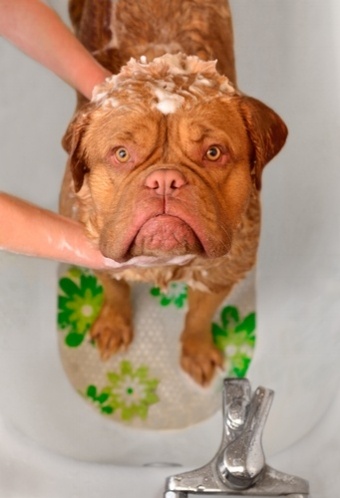 Dogs that have allergies or other medical conditions that cause sensitive skin should be bathed on a schedule approved by their veterinarian.
Dogs that have allergies or other medical conditions that cause sensitive skin should be bathed on a schedule approved by their veterinarian.
When starting treatment for sensitive skin, many dogs will need more frequent baths with prescription shampoo to help their skin recover. Once their natural skin barrier has been repaired, bathing too often might strip much-needed oils and cause more irritation.
If your dog has environmental allergies, such as grass, bathing should be done more often to help remove any allergens from their skin and coat.
Again, speak with your veterinarian to establish a bathing schedule that will work best for your dog and their needs.
Lifestyle
If your dog finds joy in rolling in every puddle of mud they come across, you'll need to bathe them more often than if your dog avoids raindrops like the plague. Owners who allow their dogs to sleep in their bed with them often bathe their dogs more frequently than others.
Dogs that spend a lot of time hiking or working dogs that spend time outdoors might need bathing more often than dogs whose jobs consist of "lap warmer" and "cuddle bug."
What You'll Need to Bathe Your Dog
Dog Brush
As you'll learn further below, brushing is crucial both before and after you give your dog a bath. Your dog's coat type determines what comb or brush will work best for detangling or de-shedding — to learn which brush type will be best for your dog's coat, read our article Caring for Your Dog's Coat: Brushing, Combing, and Mats.
Dog Shampoo
Use a shampoo formulated specifically for dogs. Avoid using human shampoos as these have too high of an acidity level for your dog's skin and coat. The pH balance of human skin is different from your dog's, and shampoos made for us can dry out their skin and coat and cause irritation from scents and other chemicals.
Dish soaps should also be avoided unless advised by your veterinarian for specific reasons, such as grease or oil-based toxins or sap. Read more about what shampoos to use and avoid in this article.
My favorite brand is Envirogroom, which comes in many different formulas — such as Oatmeal for sensitive skin, Odor Clear for removing extra stinky smells, Great White for sparkling white coats, and more!
My absolute favorite for my dogs is the Color Fixation shampoo, which enhances coat color (and smells amazing). The most popular and versatile option at the grooming shop I worked at was the Deep Clean Shampoo.
Envirogroom products are concentrated, and diluting them for each use means one bottle should last you a long time.
Conditioner
Using conditioner on your dog's coat is optional, but can be helpful in a couple of ways. It can help with detangling any knots and makes your dog's coat extra soft.
If you're bathing your dog more frequently due to sensitive skin, or if they just can't help but jump in every mud puddle, conditioning after shampooing helps to keep their skin and coat moisturized. I recommend using a leave-in spray conditioner for dogs with long coats, as it helps with post-bath brushing to prevent matting.
Avoid using conditioners made for humans, as these can disrupt your dog's pH balance and cause skin irritation.
Bathtub Supplies
Setting up your tub ahead of time will go a long way in making your bath experience more pleasant (for both you and your dog). Put down a non-slip mat for your dog to stand on to prevent them from slipping and sliding and help them feel more secure in their footing.
You can smear peanut butter or some wet dog food on your bath tiles for them to lick while you work — if you prefer an easy clean-up, use a Lick Lick Pad!
I've found the most important thing for bathing a dog at home is having an attachment hose and sprayer — it saves you from having to dump water from a pitcher and makes it easy to avoid getting water in your dog's ears, nose, and eyes. It also means you can easily rinse those hard-to-reach places.
Here are two of our team's favorites:
Members of the Preventive Vet team had this to say about the Hammerhead Showers' All Metal Pet Shower Head: "There are a lot of options to choose from when looking for a shower head with a super long hose.
What we like about this pet shower head is:
- It literally took 10 minutes to install
- The hose is really long (9 ft), which makes it really easy to spray your dog, getting those hard-to-reach places as they walk (squirm) around your tub
- It's high-quality stainless steel that should last for a long time
- It's designed in the U.S.A.
- It's not only for pet use but is a great overall shower head
- It looks really nice.
We were given a shower head to test and bathed four dogs back to back in just a few minutes each. The water pressure is adjustable, quiet, and the shampoo suds came right off.
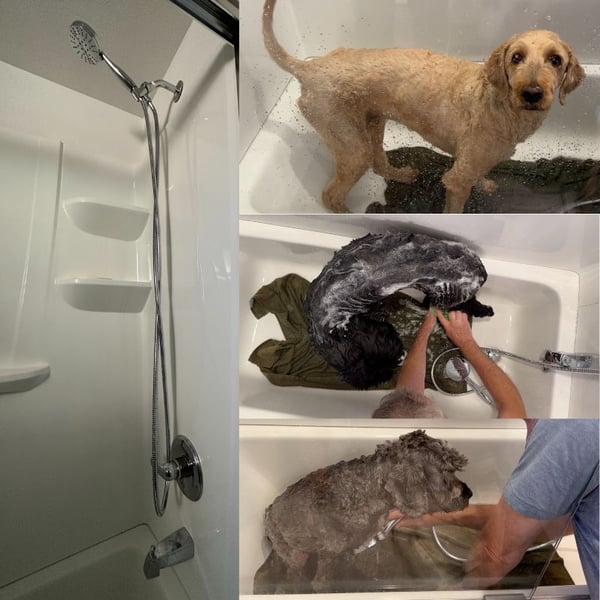
Back in 2020, a team member got the Waterpick Pet Wand. This is what she had to say, "The installation was a little tricky (we already have a removable showerhead), so trying to figure out what fitting to connect the hose to took a bit of time. Once I figured that out, the installation was very simple.
The part that connects to the shower plumbing actually has a hook on it, so you can hang the handle up and leave the wand connected all the time. Since we already have a wand-style showerhead, we reconnect the doggie wand each time.
If we ever need to get a new showerhead, I’ll get a standard showerhead so we can have the shower wand always ready for bathtime (and so I don’t need to take the time to figure out how to install it each bathtime)!"
Ear Cleaner
Cleaning your dog's ears is especially important after bathing. Help prevent ear infections by keeping water out of their ears during the bath, and then cleaning and drying them thoroughly afterward using an ear cleansing solution.
See how easy it is to clean your dog's ears in our article "How to Clean Your Pet's Ears."
Towels and Blow Dryer
No one wants a soaking wet dog running zoomies around the house after a bath! Use a super-absorbent microfiber shammy towel to make towel drying a breeze.
If your dog has a thick or long coat, blow drying is best to help prevent hot spots and lessen the chance of matting of the fur that often happens if air-dried. Regular blow dryers can do the trick, but should be used on the lowest heat setting.
A professional grooming blow dryer gets the job done much faster and helps blow out excess fur. We recommend not keeping heated airflow on the skin for long or close to the skin. Use fast nozzle movement from 1–2 feet away.
Dog Washing Steps
Brush Your Dog Before The Bath
Brushing out your dog's coat before getting them in the tub helps remove excess fur that prevents the shampoo from penetrating all the way down to the skin. This step is when you can find any mats that need detangling or trimming.
Pre-bath brushing also means you won't waste time and shampoo washing fur that will end up in the drain.
PRO TIP: For thick double-coated breeds, combine brushing with a pre-bath blow out with a professional grooming dryer to remove excess fur more easily. See how a blow-out for de-shedding is done in this video:
Apply Shampoo
PRO TIP: If you are using diluted shampoo, apply to your dog's coat before getting their fur wet for better cleaning. Rub it in and then add water to get a nice lather.
Make sure you get a nice lather of shampoo in your dog's coat that penetrates all the way to their skin. Use your fingers to work the shampoo through thick fur, or use a soft rubber brush like the KONG Zoom Groom. Don't forget to hand scrub their paws, stomach, armpits, and their tail — these are often forgotten during the bathing process.
PRO TIP: Shampooing a second time helps ensure a squeaky clean pup, but only if they don't have sensitive skin.
Avoid getting water and shampoo on your dog's face. Instead, use a dampened washcloth to moisten and wipe their face or use a special dog-safe "face wash." This one by Tropiclean is soap-free and helps remove tear stains.
You still want to avoid getting any in your dog's eyes though — spot washing with your fingers is best.
Rinse Thoroughly
After shampooing, rinse until the water runs clean of dirt and shampoo bubbles. Gravity is your friend — start rinsing from the back of their neck and between your dog's front shoulders and then work downwards to make the most of each rinse.
Don't forget to rinse all the nooks and crannies, like your dog's armpits, stomach, and between their toes.
You don't want any shampoo residue left in your dog's coat after their bath. If you notice a darker spot where the fur seems to be clumping together in their coat while drying them off, that's a sign of shampoo residue.
PRO TIP: Cover or gently pinch your dog's ears closed when rinsing and wiping that area to avoid getting any water in their ear canals. You can gently place cotton balls in your dog's ears before bathing to help keep water out — just be sure to remove them after you're done!
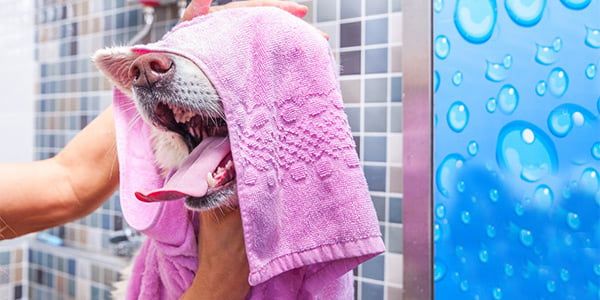
Drying Your Dog After Their Bath
It's a good idea to completely dry your dog after bathing. Moisture trapped against the skin for too long can lead to itching, skin infections, or hot spots. And damp fur gets matted much more quickly than dry fur.
For dogs that have a smooth single-layer coat, a thorough towel-dry is usually all that's needed, but for dogs with double coats or dogs with hair-like coats, blow-drying is best to make sure they're completely dry.
Drying Your Dog's Face and Head
For drying your dog's face and head, it's easiest (and more pleasant for your dog) to towel dry rather than blow dry. Towel off their face and head first, and then work on drying their body to give their face time to air dry.
If you're using a blow dryer for nearby areas, such as their chest and scruff area, use a hand to shield their ears and eyes from the blowing air. I also recommend using a Happy Hoodie while blow-drying your dog.
This helps muffle the sound of the blow dryer and protect their hearing, and can have a calming effect on many dogs.
Air Drying Tips
If you do decide to let your dog air dry, towel off as much as possible first, and then brush out their coat every few minutes while they dry. For hair-like coats, this is especially important to prevent tangles since as the coat dries it can start to curl and get knotted.
Tips for Blow Drying Your Dog
- Start with towel drying as much as possible, and spray on leave-in conditioner before starting to blow dry.
- Blow-dry in small sections and work with gravity, starting from the back of the head/neck area and moving downwards. One trick is keeping the airflow focused on one area and only moving the nozzle of the dryer in steady back-and-forth motions.
This helps to dry as quickly as possible, and also helps prevent the forced airflow from tangling up longer fur. If you move the dryer in a circular motion, you run the risk of twisting longer fur around itself.
PRO TIP: For drying longer fur, it's helpful to hold the blow dryer further away from the dog.
- Try to keep the airflow always moving and don't let it sit on one area of skin for too long (hence the slight movements back-and-forth). Professional grooming blowdryers often don't include a heating unit, but the motor still produces some heat in the airflow.
- You don't want to irritate the skin by keeping heated air concentrated on one area for too long. If you're using a human blow dryer, keep it on the lowest heat setting possible and check it frequently on your own skin to ensure it isn't too warm.
- Using a pointed nozzle on a blow dryer can help create faster airflow and quicker drying. A flat nozzle helps blow out the coat nice and straight. If and when you use a nozzle, hold it further away from your dog and only use it for drying their body and outside of their legs.
- When working on more sensitive areas (such as belly or paws), take the nozzle off for a softer airflow. When the nozzle is off, you can hold the dryer closer to your dog. While this might mean it takes a bit longer to dry those areas, it's much more comfortable for your pup.
Don't Forget the Post-Bath Brushing!
Brushing your dog after their bath will help remove any extra dead fur and detangle their coat. As you get more comfortable with blow-drying, you can start brushing while drying to save time — but it does take practice!
For tips and tricks for brushing your dog, check out our article Caring For Your Dog's Coat: Brushing, Combing, and Mats — Oh My!
Helping Your Dog Feel Better About Getting a Bath
Let's be honest — it's a rare dog that actually enjoys getting bathed. In most cases, they've learned to tolerate it and let us scrub them clean while they get some treats and praise. For many dogs, bath time can cause anxiety and stress, which can create an unsafe situation.
Some dogs react defensively and will try to bite at brushes, hoses, or hands as they are being handled. Other dogs might flail about in the tub and injure themselves trying to escape.
If your dog is still a puppy, introducing them to bathing and grooming exercises is crucial for their future bath experiences. Read this article for ways to help your puppy learn to love their spa days while they're young.
For adult dogs that have a negative association with bath time, read our article How to Help Your Dog Feel Better About Getting a Bath. It will take some time and patience, but it is possible to help them feel more secure and less anxious while getting bathed.
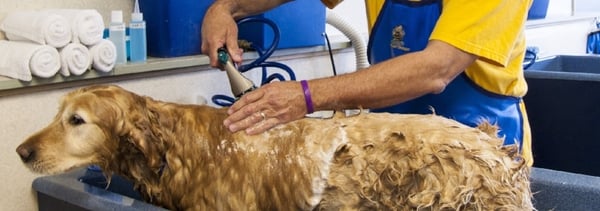
When to See a Professional Groomer for Dog Bathing
In some cases, having your dog bathed by a professional groomer is easier on everyone. Dog grooming equipment isn't cheap, and many owners don't want to buy grooming tools they'll use a few times a year.
Plus, a groomer will be able to do things like external anal gland expressions, nail trims, and even teeth brushing if requested.
Even dogs who don't need haircuts or trims can make appointments with groomers for a nice "spaw" day. While I feel confident in bathing my Corgi, Sookie, whenever I have her professionally bathed she certainly looks and feels much nicer than when I do it at home. Their blow-drying talent gets her so much fluffier than I can ever do!
Besides saving yourself the time and effort, there are other times when having your dog bathed by a groomer is recommended:
- If your dog's coat is heavily matted. Often groomers will do a preliminary clipping prior to a bath with matted coats, and then fine-tune the haircut after blow-drying.
- If your dog needs a medicated shampoo soak. If your dog is using a medicated shampoo prescribed by your veterinarian, often they need to let it soak for at least 10-15 minutes before being rinsed out. This might be too much to deal with at home and a groomer can make sure it's applied correctly and left on for the right amount of time, as well as thoroughly rinsing and drying to help sensitive skin recover.
- If your dog has fleas. A professional groomer will make sure to thoroughly wash your dog in a way that suffocates the fleas in their coat. This also gives you a chance to work on ridding your home of fleas while your dog is at their appointment. If your dog has fleas, talk with your veterinarian for the best whole-home and all-pet flea treatment and prevention plan. Learn more in our article Fleas! How to Prevent and Treat Your Dog's Greatest Nuisance.
- If your dog is difficult to bathe. Finding a Fear Free Certified groomer, or at least one who will use positive reinforcement to help your dog tolerate bathing can benefit difficult-to-bathe dogs. The last thing you want is to damage your relationship with your dog by forcing them through a bath at home, or even risking injury if they panic and lash out. A trained groomer will know what stress signals to watch for and be able to use force-free handling techniques throughout the process.
Do you bathe your dog at home? Share your favorite tips in the comments below!
Amy Dallas, Professional Pet Stylist, contributed to the contents of this article.



